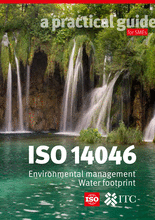
Publication 2017
ISO 14046 - A practical guide for SMEs
Environmental management - Water footprint - A practical guide for SMEs
- Publisher
- ISO
- Publisher
- ISO
Product information on this site:
Quick delivery via download or delivery service
All transactions are encrypted
About this handbook
Water is key to life, for both humans and ecosystems. However, due to growing pressure in several parts of the world, mainly from human activity, more water is being used than is being replenished.
Businesses (both directly and indirectly through their supply chain), communities and customers have started to request quantitative information about how their production processes place pressure on water resources, in order to understand and tackle issues under their responsibility. Such quantitative information is known under the concept of water footprinting. A water footprint is a metric(s) that quantifies the potential environmental impacts related to water, accounting for both water consumption and water pollution as well as considering the influence of location, timing and other relevant information.
This document targets practitioners from various backgrounds, such as large companies, public authorities, non-governmental organizations, academic and research groups as well as small and medium enterprises (SMEs). Its intention is not to detail and interpret each chapter of ISO 14046, but to provide practical guidance for carrying out a water footprint assessment.
This handbook will serve as a practical tool and a useful resource for practitioners in their efforts to understand better their dependence on water, and look at alternatives with less impact. This publication aims to help SMEs better understand the requirements of ISO 14046:2014, develop a sustainable approach to water use through the assessment of their water footprint, and to align their practices according to the International Standard. It is an important roadmap to help SMEs and policymakers measure better, meet aspects of the SDGs and contribute to a more effective sustainable management of our shared resources.
101 Pages, A5, Paper covers
Order number 18416
